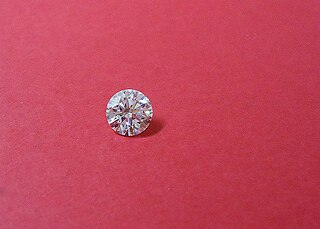
The carat (ct) is a unit of mass equal to 200 mg (0.00705 oz) or 0.00643 troy oz, and is used for measuring gemstones and pearls. The current definition, sometimes known as the metric carat, was adopted in 1907 at the Fourth General Conference on Weights and Measures, and soon afterwards in many countries around the world. The carat is divisible into 100 points of 2 mg. Other subdivisions, and slightly different mass values, have been used in the past in different locations.

Diamond is a solid form of the element carbon with its atoms arranged in a crystal structure called diamond cubic. Another solid form of carbon known as graphite is the chemically stable form of carbon at room temperature and pressure, but diamond is metastable and converts to it at a negligible rate under those conditions. Diamond has the highest hardness and thermal conductivity of any natural material, properties that are used in major industrial applications such as cutting and polishing tools. They are also the reason that diamond anvil cells can subject materials to pressures found deep in the Earth.

Pike County is a county located in the U.S. state of Arkansas. As of the 2020 census, the population was 10,171. The county seat is Murfreesboro. Pike County is Arkansas's 25th county, formed on November 1, 1833, and named for Lieutenant Zebulon Pike, the explorer who discovered Pikes Peak. It is an alcohol prohibition or dry county. The current judge is Dewight Mack.

Murfreesboro is a city in, and the county seat of, Pike County, Arkansas, United States. Its population was 1,641 at the 2010 census. The city is known for the Crater of Diamonds State Park located south of the city.

Crater of Diamonds State Park is a 911-acre (369 ha) Arkansas state park in Pike County, Arkansas, in the United States. The park features a 37.5-acre plowed field, the world's only diamond-bearing site accessible to the public. Diamonds have continuously been discovered in the field since 1906, including the graded-perfect Strawn-Wagner Diamond, found in 1990, and the Uncle Sam, found in 1924, which at over 40 carats is the largest diamond ever found in the United States.

The Argyle Diamond Mine was a diamond mine located in the East Kimberley region in the remote north of Western Australia. Argyle was at times the largest diamond producer in the world by volume, although the proportion of gem-quality diamonds was low. It was the only known significant source of pink and red diamonds, and additionally provided a large proportion of other naturally coloured diamonds, including champagne, cognac and rare blue diamonds.
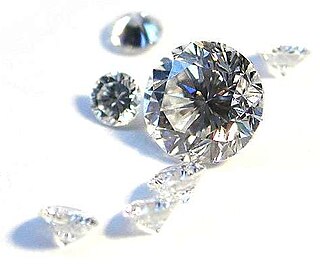
A diamond cut is a style or design guide used when shaping a diamond for polishing such as the brilliant cut. Cut does not refer to shape, but the symmetry, proportioning and polish of a diamond. The cut of a diamond greatly affects a diamond's brilliance; this means if it is cut poorly, it will be less luminous.

A chemically pure and structurally perfect diamond is perfectly transparent with no hue, or color. However, in reality almost no gem-sized natural diamonds are absolutely perfect. The color of a diamond may be affected by chemical impurities and/or structural defects in the crystal lattice. Depending on the hue and intensity of a diamond's coloration, a diamond's color can either detract from or enhance its value. For example, most white diamonds are discounted in price when more yellow hue is detectable, while intense pink diamonds or blue diamonds can be dramatically more valuable. Of all colored diamonds, red diamonds are the rarest. The Aurora Pyramid of Hope displays a spectacular array of naturally colored diamonds, including red diamonds.

The Gemological Institute of America (GIA) is a nonprofit institute based in Carlsbad, California. It is dedicated to research and education in the field of gemology and the jewelry arts. Founded in 1931, GIA's mission is to protect buyers and sellers of gemstones by setting and maintaining the standards used to evaluate gemstone quality. The institute does so through research, gem identification and diamond grading services and a variety of educational programs. Through its library and subject experts, GIA acts as a resource of gem and jewelry information for the trade, the public and media outlets.
Haggertyite is a rare barium, iron, magnesium, titanate mineral: Ba(Fe2+6Ti5Mg)O19 first described in 1996 from the Crater of Diamonds State Park near Murfreesboro in Pike County, Arkansas. The microscopic metallic mineral crystallizes in the hexagonal system and forms tiny hexagonal plates associated with richterite and serpentinitized olivine of mafic xenoliths in the lamproite host rock. It is an iron(II) rich member of the magnetoplumbite group. It is a light grey opaque mineral with calculated Mohs hardness of 5.

The American Gem Society (AGS) is a trade association of retail jewelers, independent appraisers, suppliers, and selective industry members, which was founded in 1934 by Robert M. Shipley.
The incorporated town of Kimberly, a sparsely inhabited area on the south side of Murfreesboro, Arkansas, began in late 1908 as an ill-fated land-development project spanning almost 240 acres (0.97 km2). At the time, the recently discovered Arkansas diamond field was still generating a speculative heyday, and the enterprising property owner, Millard M. Mauney, envisioned a dynamic settlement based upon a future mining industry. His location was perfect. The diamond field lay only a half-mile away. The planned extension of a railroad into Murfreesboro from the southwest would cut through Kimberly, facilitating investments and development.
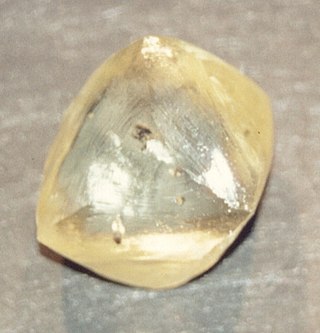
Diamonds were largely inaccessible to investors until the recent advent of regulated commodities, due to a lack of price discovery and transparency. The characteristics of individual diamonds, especially the carat weight, color and clarity, have significant impact on values, but transactions were always private. With the standardized commodity as an underlying asset, several market traded financial instruments have been announced.
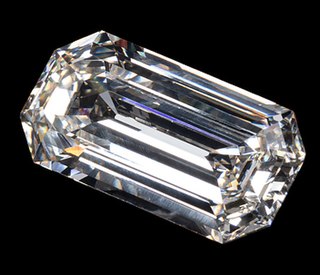
Uncle Sam is the nickname for the largest diamond ever discovered in the United States. It was found in 1924 in Murfreesboro, Arkansas at the Prairie Creek pipe mine, which later became known as the Crater of Diamonds State Park. The diamond was named "Uncle Sam" after the nickname of its finder, Wesley Oley Basham, a worker at the Arkansas Diamond Corporation.

The Star of Murfreesboro is a 34.25 carats (6.850 g) blue diamond that is eleven-sixteenths of an inch in diameter. The diamond was found by John Pollock at the Arkansas Diamond Mine near Murfreesboro, Arkansas. Pollock found the diamond on March 1, 1964. It is the largest diamond ever found by a tourist in the Arkansas area. It was valued at $15,000.00 in 1964.

Diamond is one of the best-known and most sought-after gemstones. They have been used as decorative items since ancient times.
The Amarillo Starlight is the largest diamond found by a park visitor in the Crater of Diamonds State Park in Arkansas since 1972, when it was established as a state park. The Amarillo Starlight was found by W. W. Johnson of Amarillo, Texas in 1975 while he was vacationing at the park with his family. When unearthed, it was a 16.37 carats (3.274 g) white diamond, but it has since been cut into a 7.54 carats (1.508 g) marquise shape. Its value has been estimated between $150,000 and $175,000.
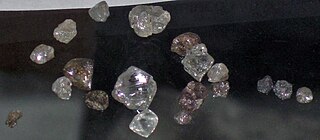
Kelsey Lake Diamond Mine is a defunct diamond mine in Colorado, USA. It is located in the State Line Kimberlite District, near the Wyoming border, and consists of nine kimberlite volcanic pipes, of which two were open pit mined.
Graff is a British multinational jeweller based in London. It was founded by British jeweller Laurence Graff in 1960. A vertically integrated company, Graff operations comprise the design, manufacture and retail distribution of jewellery and watches.
Mike Botha is a Canadian diamond cutter.













